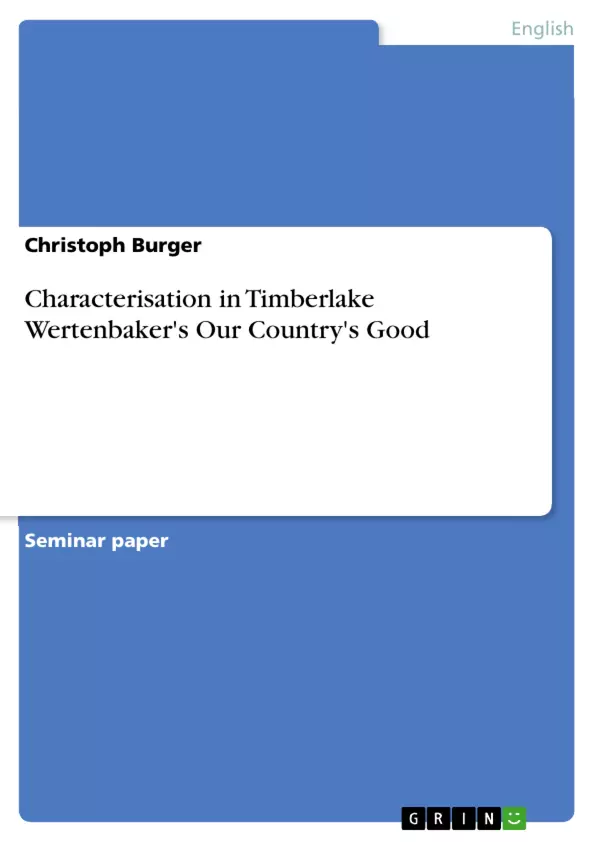In this paper I investigate the development of characterisation in the play "Our Country’s Good" by Timberlake Wertenbaker. The term characterisation refers to the way new characters are introduced and created. Throughout my analysis I will propose that a character has a specific trait, which I will back up with empirical evidence such as passages from the book where characters are characterized explicitly.
This paper will also be shaped by the following central questions: Which methods are used by what means? What does the author achieve by using these techniques? Which techniques are combined with which characters and why? However, a full discussion of all the characters in the book would go beyond the scope of this paper, since the play includes 22 characters in no more than 91 pages (cf. Wischenbart, 93). This led me to a completely different approach, namely to single out two of the main characters in the play and juxtapose them in terms of characterisation and character development. But before I turn to the full analysis of my central topic, I will clarify the exceedingly important role characterization plays in drama and define the different main concepts and techniques of it.
The relevancy and great impact of the process of characterisation to the reader becomes clear when literature on the theory of drama is examined. According to Hoffmann, ‘drama depends on the presentation of fictional personalities as the principal vehicle to communicate the message the artists want to convey’ (Hoffmann, 1).
Table of Contents
- Introduction
- Characterisation of different characters
- CAPTAIN ARTHUR PHILLIP
- MARY BRENHAM
- Conclusion
Objectives and Key Themes
This paper analyzes character development in Timberlake Wertenbaker's play, Our Country's Good. It examines the author's methods of characterization, focusing on specific techniques and their effects. The analysis centers on two main characters, juxtaposing their development and the methods used to portray them.
- Characterisation techniques in drama
- The portrayal of Captain Arthur Phillip
- The portrayal of Mary Brenham
- Comparison of character development methods
- The impact of characterization on conveying the play's message
Chapter Summaries
Introduction: This chapter introduces the paper's objective: to analyze characterization in Our Country's Good. It defines characterization, drawing on existing literary theory, and outlines the methodology, focusing on Captain Arthur Phillip and Mary Brenham as case studies.
Characterisation of different characters: This section begins the in-depth analysis of characterization. It starts by examining the portrayal of Captain Arthur Phillip, highlighting his contrasting attitudes towards the convicts and the other soldiers. The section details how the author uses various techniques, including both implicit and explicit characterization, to present Phillip's character.
Keywords
Characterisation, Timberlake Wertenbaker, Our Country's Good, Captain Arthur Phillip, Mary Brenham, dramatic techniques, character development, literary theory.
- Quote paper
- Christoph Burger (Author), 2005, Characterisation in Timberlake Wertenbaker's Our Country's Good, Munich, GRIN Verlag, https://www.grin.com/document/119910



